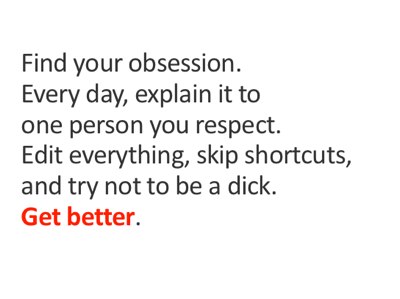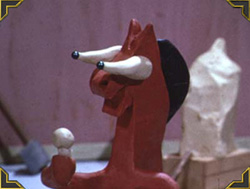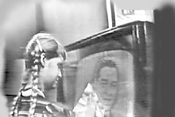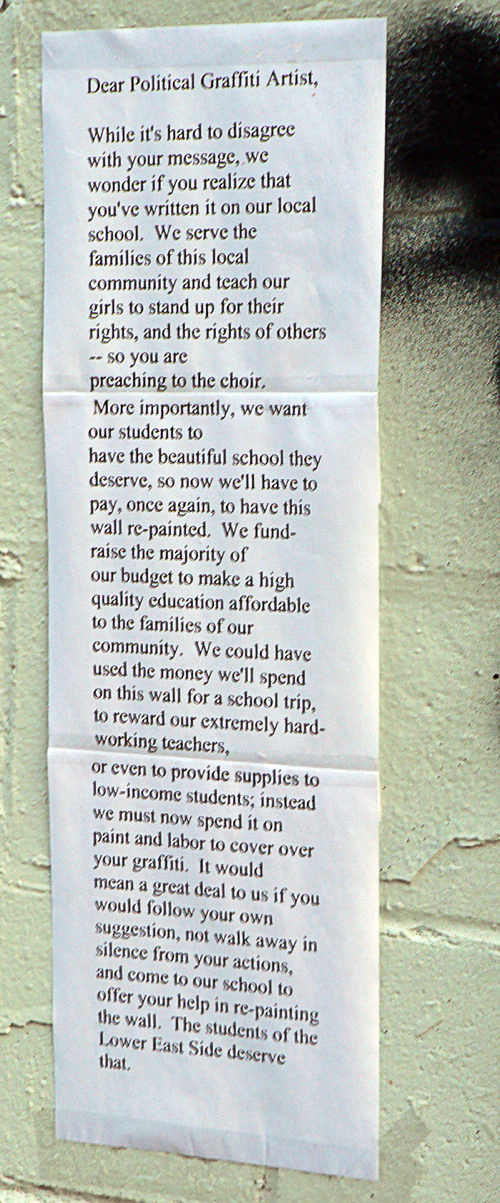Who let Jason Jones of the Daily Show in to talk to New York Times staffers? Hilarious and on the money.
| The Daily Show With Jon Stewart | Mon – Thurs 11p / 10c | |||
| End Times | ||||
|
||||

Tilting at windmills for a better tomorrow.
Who let Jason Jones of the Daily Show in to talk to New York Times staffers? Hilarious and on the money.
| The Daily Show With Jon Stewart | Mon – Thurs 11p / 10c | |||
| End Times | ||||
|
||||
I have a confession to make to people who count me as a “friend” on Facebook: I don’t “do” Facebook. Yes, you do see a lot of status updates from me on FB, but I don’t post them there directly. Truth is, I’m pathetically Twitter-obsessed, and use a pair of Facebook apps to funnel my Twitter posts (“Tweets”) and blog entries directly to FB. So while I do have a Facebook account, I never spend time surfing around on it, which means I may not see your updates unless you’re also on Twitter. Is that rude or uncongenial? It’s not that I’m trying to avoid you, but that I prefer to avoid the high noise-to-signal ratio on FB (I find Twitter much more focused).
In addition – and this may sound funny coming from a tech nerd like me – I find Facebook completely confusing. Am I posting to your wall or my wall? Wall-to-wall? Is that same as posting to your inbox? Is this a private message? I’m never quite clear whether what I’m writing on FB is going to be publicly visible or not. When installing a FB app, I’m never quite clear how much info I’m giving away, how much tracking I’m allowing. I recently replied to a group discussion on FB and ended up with a flood of content-free noise in my email inbox for the next two weeks. Every person replying on the thread generated an email to me, and there was no apparent way to unsubscribe from the thread.
Basically, Facebook seems like one big, nasty, unfocused clusterbomb to me. While Twitter has its own share of noise (depending on whom you follow), I find it much easier to dial in to my own work and conversation patterns, easier to distinguish public from private on, easier to find focused information, and just more pleasant to work with in general. See Guy Kawasaki on the Power of Twitter and Tim O’Reilly’s Why I Love Twitter.
If a bunch of you tell me that it’s rude of me to auto-post to Facebook without actually participating in it, I’ll stop. Just let me know.
Twitter’s best tweeter Merlin Mann (more famously of GTD and 43 Folders) abruptly stopped with the twitter thing in early September, and started blogging at kungfugrippe.com. Completely different style, hard to tell it’s the same dude. But loved this slide from a presentation on effective blogging, applicable to Just About Anything:

The old Bowie and Springsteen vids are also worth watching.
Gearing up for another big week of webcasting, as we prepare to guide another group of visiting journalists through a week-long new media technology bootcamp. As always, we’ll have a bunch of great speakers during lunches and dinners, and those presentations are open to the public. Can’t make it to Berkeley? Check out the live webcasts. Especially Looking forward this week to Chad Dickerson of the Yahoo! Developer Network, and Richard Koci Hernandez, deputy director of photography for the San Jose Mercury News.
![]() Twitter (microblogging in general) is changing the way I communicate and consume. With ever-shrinking windows of available free time, the self-imposed expectations/pressure to blog something every night, or even a few times a week, melts away. Instead, I drop quick thoughts and notes into the ether as they occur. The 140-character length limit means there’s never any expectation that thoughts be fully formed. Maybe that’s yet another sign of cultural acceleration and the cheapniss of snack-sized media, but it works for me.
Twitter (microblogging in general) is changing the way I communicate and consume. With ever-shrinking windows of available free time, the self-imposed expectations/pressure to blog something every night, or even a few times a week, melts away. Instead, I drop quick thoughts and notes into the ether as they occur. The 140-character length limit means there’s never any expectation that thoughts be fully formed. Maybe that’s yet another sign of cultural acceleration and the cheapniss of snack-sized media, but it works for me.
Twitter has also become a partial cure for my ongoing failure to actually read anything. Hundreds of feeds in the RSS reader, thousands of bookmarks, and I rarely look at anything that doesn’t find its way into my inbox. But for some reason, I actually take time out to consume what’s going down in the Twitter stream — it’s become a partial cure for bad media consumption habits. Twitter has become a 2nd inbox, perhaps more playful than the first, but essential nonetheless. Twitter has clicked for me in a way no other social network has.
In the few months I’ve been on the service, Twitter has found my phone, I’ve been able to follow one of our J-School students as he was jailed (and then freed) in Egypt for covering riots, I’ve gotten music and software recommendations, watched as journalists experimented with new ways to reach their drifting audiences, gotten to listen in on conferences there would be no way I’d have time to attend…
At times it almost feels like Twitter should have its own internet protocol, like it’s something new altogether. Not quite IRC, not quite IM, not quite blogging, not quite RSS. It’s all of those things synergized, yet still http-based.
Twitter-holics deal constantly with Twitter’s outages, which have become a near-daily occurrence. Talk about a killer app — what other service’s userbase would remain so loyal with such consistently bad uptime?
Twitter is built on Ruby on Rails, which has taken a lot of heat in recent months as a result – much buzz about how Rails doesn’t scale. But remember: “Languages don’t scale, architectures do.” And that’s the rub – Twitter was built quickly, with all the wrong assumptions, without foresight into the complexities that would be brought on by massive popularity 18 months later.
The issue is that group messaging is very difficult to achieve at a grand scale.
Excellent article at Hueniverse on Twitter’s scalability challenges. Summary: Rails is a framework used primarily for building content management systems. But Twitter isn’t a CMS at all – it’s a messaging system and an API. While most web apps read from the database hundreds of times more frequently than they write, Twitter is writing constantly, which creates a whole different kind of strain. And while most web apps depend heavily on caching to maintain performance, Twitter is cache-resistant, since every single user has a unique view, and each user’s view needs to be refreshed constantly. Caching need not apply. And since the API is both public and powerful, multiply the strain x dozens or hundreds of external desktop clients and filtering sites and services.
Twitter is currently being rebuilt piece-by-piece, and things are slowly getting better. There are rumors that the rebuilt components are all written in PHP, though the company denies the rumors.
Tip: To make Twitter work for you, you need a desktop client. I use Twitterific. And don’t be afraid to follow strangers. Check out who you’re following are following.
 One of the excellent things about being a parent is the endless opportunity to re-live your childhood. In high school, Gumby was mostly the subject of satire… we had grown up watching 1950s/60s Gumby shorts in the 1970s. In the 80s, mocking Gumby was fun because it had been a staple of our own childhoods, even though that staple had already been retro when we were tykes. But while we made lots of Gumby jokes and loved to quote from Eddie Murphy’s 1982 SNL Gumby reprisal, and while I even made a foam Gumby costume for halloween ’82, I hadn’t seen any of the actual episodes since early childhood.
One of the excellent things about being a parent is the endless opportunity to re-live your childhood. In high school, Gumby was mostly the subject of satire… we had grown up watching 1950s/60s Gumby shorts in the 1970s. In the 80s, mocking Gumby was fun because it had been a staple of our own childhoods, even though that staple had already been retro when we were tykes. But while we made lots of Gumby jokes and loved to quote from Eddie Murphy’s 1982 SNL Gumby reprisal, and while I even made a foam Gumby costume for halloween ’82, I hadn’t seen any of the actual episodes since early childhood.
Rented a volume of early episodes recently to show Miles, and was taken by surprise — they’re so completely different from my early memories. I remember “Gumby” as innocent and simple, and it is. But it’s also incredibly surreal, and charmingly/badly produced. The stiffest voice acting you can imagine. Ridiculous plot and prop inconsistencies. The clay in Gumby’s body tearing between the legs and Clokey not even bothering to edit it out. Strange animations scattered throughout the stories for no particular reason… you can almost visualize the animators making it up as they went along: “Hey, what if a musical note jumped out of this red vinyl LP and down Gumby’s throat?” Sure, why not. Spontaneously bizarre.
 Everything in the Gumby universe starts with “Gumb___.” Gumby and his family live in Gumbasia. Gumby’s mother and father are called Gumba and Gumbo. Gumba reminds Gumby every time he leaves the house, “Don’t forget to take your Gumbopiture!” — a bizarre reference to a recurring prop — a sort of circular thermometer that measures Gumby’s health relative to his temperature (clay is stiff when cold, runny when warm; Art Clokey seems to have been obsessed with the plot possibilities presented by clay’s thermal properties).
Everything in the Gumby universe starts with “Gumb___.” Gumby and his family live in Gumbasia. Gumby’s mother and father are called Gumba and Gumbo. Gumba reminds Gumby every time he leaves the house, “Don’t forget to take your Gumbopiture!” — a bizarre reference to a recurring prop — a sort of circular thermometer that measures Gumby’s health relative to his temperature (clay is stiff when cold, runny when warm; Art Clokey seems to have been obsessed with the plot possibilities presented by clay’s thermal properties).
Another recurrent effect I had no memory of: Every time Clokey needed to show fire or smoke (dragon’s breath, burning wheat, steaming pools…), he created the effect by scratching at or burning the physical film (and by the looks of it, dousing it with chemicals from time to time). At one point, Gumby steals a hot rod and starts spinning donuts (I kid you not). The smoke reeling from his tires looks like Clokey just scribbled on the film with Magic Marker. It’s brilliant.
 I had completely forgotten the excellent way Gumby gets around. Rather than animating him walking, Clokey just propped him up on one leg and slid him across the floor – an inexplicable one-foot slide/skate move that makes you wonder whether Gumby actually has some kind of undulating foot pad, like a super-fast mollusk. It’s just weird, totally cheap, and totally wonderful.
I had completely forgotten the excellent way Gumby gets around. Rather than animating him walking, Clokey just propped him up on one leg and slid him across the floor – an inexplicable one-foot slide/skate move that makes you wonder whether Gumby actually has some kind of undulating foot pad, like a super-fast mollusk. It’s just weird, totally cheap, and totally wonderful.
Nothing about watching Gumby episodes from the 60s while in your 40s matches your early childhood memories. Everything is cheaper, more hokey, more cliche’d, more technicolor. A TV show (even a kids show) being made this badly today would never get signed. These classic episodes would hardly even pass for rough cuts in today’s big-budget TV universe. But the constraints of small budgets allowed Clokey and the animators to think off-the-cuff and improvise like crazy. There were only three channels at the time, and no one cared that it was hokey – maybe that’s what we all loved about it (ultimately, Gumby became a 223-episode series stretching over 35 years).
After a few evenings of watching Gumby re-runs with Miles, I asked him what he thought:
“Well, it doesn’t amount to much, but it’s sure interensting!”
Right on.
 Great talk by futurist Paul Saffo tonight (sorry, he declined to be webcast at the last minute). Covered a lot of ground, with both inspiring and depressing intersections for journalists, but I especially enjoyed his romp through early “new media” technologies, including what must have been the first interactive television program, Winky Dink and You. Kids hung a piece of clear acetate with a connect-the-dots or other puzzle over the TV screen, and got to “rescue” Winky Dink by drawing a ladder, rope, or other device right on the screen at the right moment (subversive 50s kids apparently drew anvils or bombs to sabotage him instead). Clues given through the show led to the spelling out of a secret message.
Great talk by futurist Paul Saffo tonight (sorry, he declined to be webcast at the last minute). Covered a lot of ground, with both inspiring and depressing intersections for journalists, but I especially enjoyed his romp through early “new media” technologies, including what must have been the first interactive television program, Winky Dink and You. Kids hung a piece of clear acetate with a connect-the-dots or other puzzle over the TV screen, and got to “rescue” Winky Dink by drawing a ladder, rope, or other device right on the screen at the right moment (subversive 50s kids apparently drew anvils or bombs to sabotage him instead). Clues given through the show led to the spelling out of a secret message.
Of course, it goes without saying that scores of kids without the kits drew on the television screen itself, ruining many a family’s first television set. “I remember that my Mother didn’t want to buy me a Winky Dink screen,” Charlie Jamison writes, “That was not going to stop me from helping my old pal Winky Dink, I just used a permanent marker! The next week, I had a Winky Dink screen.”
Also enjoyed Saffo’s collection of early remote controls (everyone still has a relative alive who calls it “the clicker,” right?
Also could relate to his “Bakelite” metaphor – when plastics first hit the scene, they worked hard to make new products look like wood or tortoise shell – the new tech was using itself to emulate the old. Since I’ve been dealing with two separate faculty members who want to put up web publications in a Flash “page turning” interface because they “just like the feel of print,” the Bakelite analogy resonated perfectly.
Other examples: The Gutenberg Bible looked just like an illuminated manuscript – print was introduced and the first thing it did was emulate the old hand-styled presentation method. And when TV was introduced, for years it just did stand-up radio shows, but with a camera on the hosts.
 My attempt to sell off boxes of 30-year-old+ comics was an abject failure. The market is flooded, the internet is taking over the comic space, etc. etc. Especially disheartening was that I couldn’t find a good home for all my old Mad magazines. Thumbing through the boxes a few months ago, had to take time out to do a bunch of Mad Fold-Ins — the back page was always a treat, and every issue has vertical creases at the 1/3 points. Creator Al Jaffe (now 86) has been creating the fold-ins by hand almost non-stop since 1964.
My attempt to sell off boxes of 30-year-old+ comics was an abject failure. The market is flooded, the internet is taking over the comic space, etc. etc. Especially disheartening was that I couldn’t find a good home for all my old Mad magazines. Thumbing through the boxes a few months ago, had to take time out to do a bunch of Mad Fold-Ins — the back page was always a treat, and every issue has vertical creases at the 1/3 points. Creator Al Jaffe (now 86) has been creating the fold-ins by hand almost non-stop since 1964.
The New York Times is featuring an excellent collection of fold-ins, with interactivity expertly re-created in Flash.
Weblog comment spam rates continue to surge. This chart is from one installation of anti-blog-spam tool Defensio, showing an insane uptick through the last part of March, 2008:

(Thanks ViperBond). Akismet’s charts show more than 5 billion blog spams identified in the past two years. I’ve personally noticed a dramatic increase in hand-written blog spam recently. Knowing that tools like Defensio and Akismet are going to get spammers banned from blogs net-wide within minutes, the method is now one of social engineering – getting bloggers to consciously allow spammy comments to go live by making them highly relevant to the post they’re attached to, and plausibly written. All that distinguishes this latest form are the author URLs — which no longer point to cialis and poker sites, but to tile shops, beauty parlors, commercial art galleries, pool-cleaning supply houses, etc. Human blog spammers have been around almost as long as bots (to defeat captchas, etc.) but this latest form amazes me because it’s written so carefully. I really have to puzzle over some of these recent ones to decide whether to push them through or not.
Because Akismet is less likely to have identified these as spammy, the moderation burden falls back onto blog authors. It’s no longer possible to identify spam at a glance – we now have to study each message carefully to ascertain sincerity.
Note: Despite the date, this is not an April Fool’s post. Can’t believe I have to say that.
“Don’t walk away in silence,” someone spray spraypainted on the wall of a girls school on the lower east side, New York. The school painted over it, of course, and left this note in its place:

The school turned the episode into a teachable moment. “It really gave us a chance to engage in a dialogue with our students.”
via GammaBlog